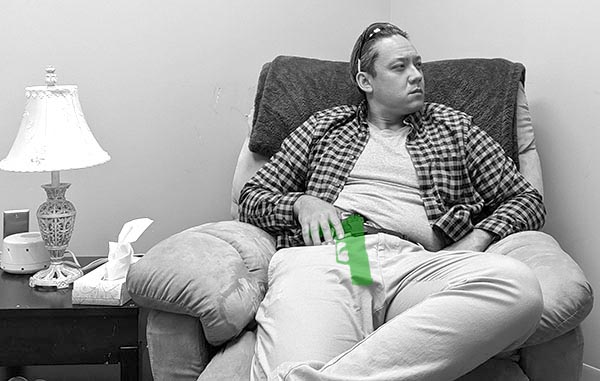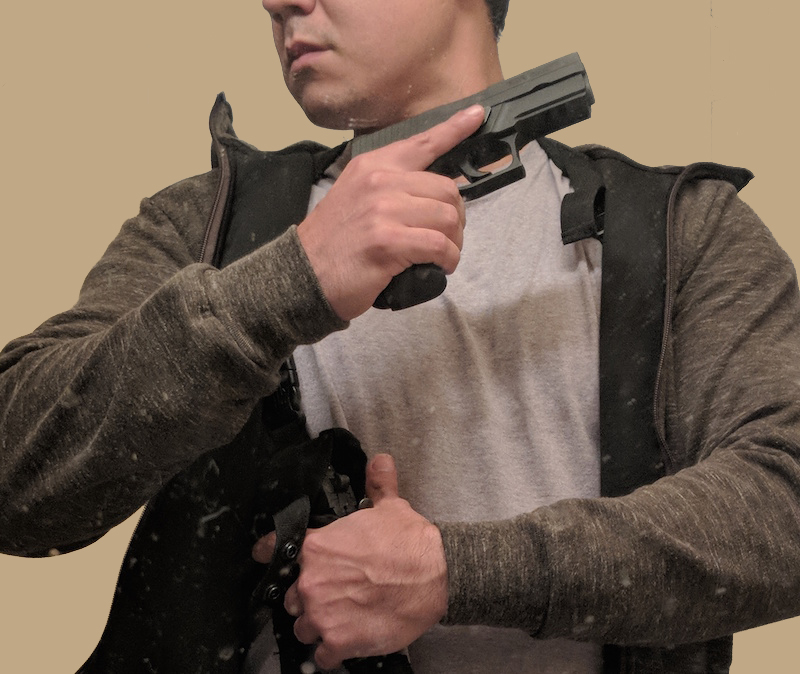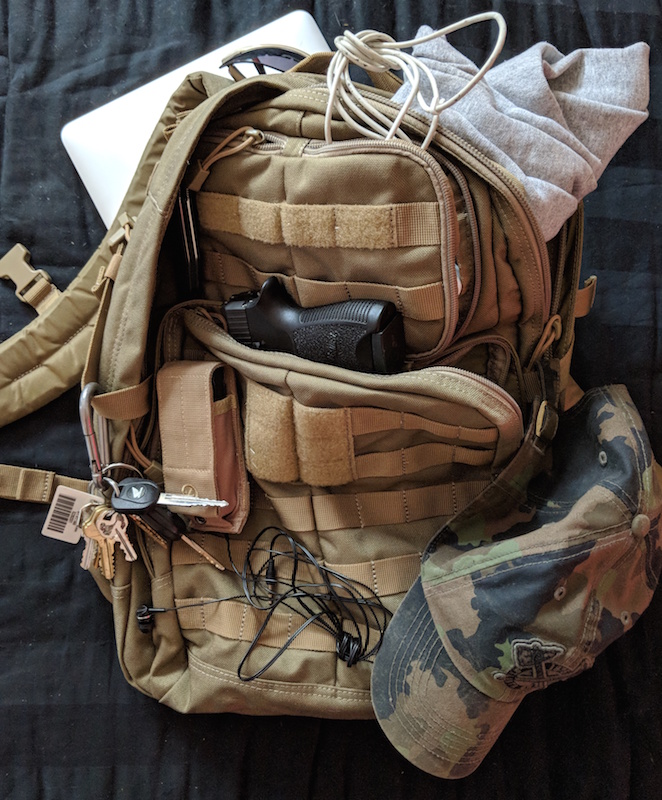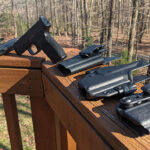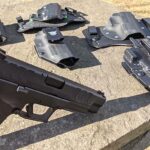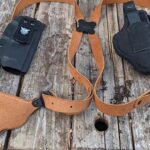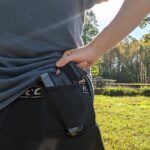Appendix carry is a popular position for toting your everyday carry pistol. However, many concealed carry practitioners do not opt to carry their pistol in this position. Oftentimes, people cite discomfort as a primary reason behind this decision. There are several ways to alleviate discomfort and below are some tips on how to appendix carry comfortably.
- Follow natural contours of your body
- Adjust ride height for your activity
- Modify holster cant to prevent discomfort
- Utilize holster accessories
Personally, I don’t generally carry my pistol in the appendix position. However, my concerns are largely safety concerns (albeit mostly psychological) as opposed to comfort. Throughout the years, I’ve tested various concealed carry positions and have found little tricks to aid concealment and comfort.
NOTE: I recommend you try appendix carry for at least a week of daily use before quitting on this concealed carry location. Oftentimes people decide the position is uncomfortable before discovering where they should even be carrying. Like many other concealed carry placements, finding your placement is very personal. I can provide you tips to assist, but truth be told appendix carry is more of an art than a science.
Table of Contents
What Is Appendix Carry?
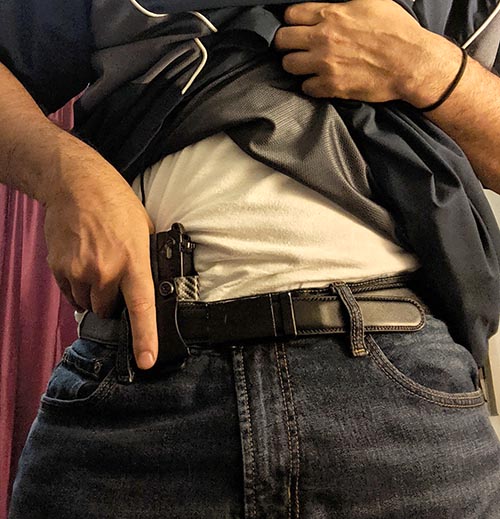
Appendix carry is aptly named, because your holster will rest against your abdomen in the general location of your appendix (see the image above). Generally, this position is used with an IWB holster to aid in concealment — often referred to as AIWB.
However, there is not a set location for your concealed carry and you will need to experiment with pistol location to find what is most comfortable. A good point of reference is to think of your torso as a clock face. If your belly button is pointing to the 12 o’clock position then the appendix carry position is usually somewhere between 1-2 o’clock.
Advantages of Appendix Carry
There is much debate about which concealed carry position is “the best.” Your style of shooting, concealed carry preferences, goals, and more will dictate which position is best for you. However, we’re only talking about appendix carry here.
One of the biggest benefits of appendix carry is the ease of drawing your pistol. Many practitioners cite the natural feel of un-holstering the handgun from this position. I’ve found there to be merit to this, as my hand position simulates the motion used for reaching into my pocket.
Furthermore, when un-holstering a firearm, it’s easier to clear the pistol grip from loose clothing from the appendix carry position. During some trials at the shooting range, my clothing was far less likely to snag on the holster clip or pistol grip in the AIWB position than hip or other waistline carry positions.
Another benefit is for those who choose to wear body armor as part of their EDC. Generally, you want to present a smaller target to an attacker. The easiest way to do this is by rotating your torso. However, body armor is generally weakest on the sides of the vest. Therefore, drawing from appendix carry keeps your chest (structurally strongest part of bullet proof vest) facing your target.
Your Body Type And Appendix Carry
Concealed carry in the appendix position is going to vary based on your body style. Skinny guys need to avoid holster contact with bony areas, particularly with rigid holsters. Bigger guys are going to want to avoid pinching skin and fat with their holster by adjusting ride height. Regardless, I suggest you check out this article on pant sizing, which has universal tips for IWB carry. It’s worth a look whether you’re skinny or fat if your goal is to appendix carry comfortably.
Appendix Carry For Skinny Guys
Skinny guys are at a disadvantage for carrying in the appendix position. Oftentimes, bony protrusions (like their hip bone) are a cause for discomfort. In order to make AIWB carry comfortable for skinny guys, you should avoid pistol cant.
Canting your pistol can lead to the butt plate of your magazine digging into your hip bone. A vertical orientation is going to be more comfortable for appendix carry on skinny guys. Alternatively, if you are more comfortable with a canted holster, you may need to move your IWB holster closer to the center line of your body. A little cant will go a long way, do not over cant your holster to prevent a dangerous muzzle position.
Additionally, skinny guys will want to appendix carry with a holster that has a slightly elevated ride height. Unlike fat guys, you won’t need to worry as much about skin getting pinched. However, the ride height will prevent the muzzle from pressing into your lower abdomen and hip flexors when seated.
The biggest concern for AIWB carry for fat guys is digging. Oftentimes, when sitting the rear of the pistol can jab into your midsection. Your choice in clothing can help alleviate this problem. Smooth, tight-fitting clothing, similar to material used in the 5.11 tactical compression shirt is best. However, more on that later.
Appendix Carry for Fat Guys
My weight fluctuates pretty intensely (+/- 40 lbs depending on the season), so I feel like I can speak to the larger fellas in the concealed carry community. If you want to appendix carry as a fat guy you’ll need to lower the ride height of your holster.
Lowering the ride height of your holster will help prevent the fat and skin on your gut from getting pinched by the rear of your slide. Of course, if you wear your pants lower on your waist this may not be necessary. You’ll need to experiment to find the ideal ride height.
Unlike skinny guys, I do recommend canting your holster slightly if you’ve got a big belly. Usually, a slight cant is sufficient to alleviate any discomfort in the appendix carry position whether seated or standing. However, be advised that the greater the cant, the more likely you are to muzzle your femoral artery or your genitals. Fat guys generally don’t need to worry about their pistol digging into their hip bone in the appendix position because they’ve got a bit more cushion.
To make appendix carry more comfortable with your holster, try to follow the hip flexor line with the contour of the holster where the trigger guard sits. With a lower ride height, the rear of your pistol should sit below your stomach, and the muzzle will be pointed toward the opposite foot. Canting the pistol will help prevent digging when in the seated position.
Adjust Ride Height and Cant For AIWB Carry
There are several techniques (some I’ve already discussed) to prevent appendix carry digging. Usually, appendix carry digging occurs in the seated position. Either, the muzzle ends up digging into the lower abdomen and hip flexors, or the pistol grip digs into the hip bone. Alternatively, some people experience discomfort in the middle abdomen from the pistol slide or hammer.
Appendix Carry and Ride Height
Sometimes, raising the ride height of your IWB holster can prevent the pistol grip from digging into your hip bone. Unfortunately, the higher the pistol rides, the more likely the grip will hinge at the belt line. This causes the pistol grip to protrude, resulting in printing. Additionally, when the pistol grip extends away from the body it can also result in discomfort. There are some holster accessories that can help mitigate this reaction, but I’ll cover those in a later section.
Lowering the holster ride height is another tactic for making appendix carry more comfortable. Usually, a slight holster cant will prevent the muzzle from digging. Effectively, you’ll be creating an angle that mirrors the crease between your hip flexor and opposite big toe.
You’ll need to check that your appendix carry holster allows you to adjust the ride height. Generally, there is a screw that can be loosened to allow the clip to move. Sometimes, the clip can actually be relocated to another spot on the holster. However, adjustment ranges will vary, but I’ve found most holsters allow between 1-2″ of ride height adjustment.
AIWB Carry: Cant or No Cant
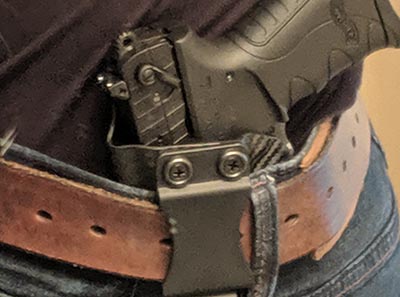
If it hasn’t become apparent, I’m a big fan of canted holsters. However, having the ability to cant your pistol is a great way to prevent discomfort when concealed carrying in the appendix position. For me, I will cant certain holsters so that the muzzle is just to the outside of the pubic bone. Doing this allows the holster outline to follow the natural contour of my hip flexors.
Another less orthodox way to carry in the appendix position, is with a cross draw. Instead of keeping the holster on your dominant side, your pistol will be on the non-dominant side for cross draw. Pistol cant can be important for both the ability to draw the handgun and for comfort when using appendix cross draw. However, you trade off safety for comfort if your cant is too great.
When using cross draw appendix carry, the biggest point of discomfort I found is the muzzle. With the cant of the holster, it’s tough to find a comfortable position. However, if you are able to move the holster close to inline with the navel, you can tuck the muzzle into the crease of your hip flexor. Unfortunately, it’s troublesome to utilize the cross draw appendix carry when using a belt. Either you can’t tuck the free end of the belt into pant loops, or you need to place your holster clip over. For me, neither option is ideal, so I stick to strong side appendix carry.
Appendix Carry Holster Accessories
If you’ve taken my advice and have spent a week trying to find the right location but there’s still something off, there are a couple of accessories you might want to test. First, there is the holster wedge which can cut down on digging of the muzzle. Alternatively, you can use a holster claw for appendix carry, which forces the pistol grip flush with your torso.
Holster Wedge
Holster wedges are a popular choice for making appendix carry more comfortable. Usually, there is a foam wedge that attaches at the muzzle end of the holster decreasing the hinge of the clip on the belt line. Oftentimes it is held in place using velcro attachment. Depending on the style of appendix holster (i.e. sidecart appendix holster) you may need a non-traditional wedge.
Another benefit of a holster wedge is the cushioning provided. Soft foam takes the place of hard edges of a kydex holster, making sitting with an appendix holster more comfortable.
Holster Claw/Wing
Essentially, the holster claw forces the rotation of your pistol to tuck the pistol grip close to your body. So how does this tool affect comfort? A holster claw is attached at the muzzle end of your holster. Sometimes, the holster by itself will not flush the pistol grip to your body. Therefore, a holster claw decreases the likelihood of the muzzle end of the holster digging into your thigh or lower abdomen by covering a larger surface area and rotating the butt of the grip inward.
Additionally, the holster claw can help determine the ride height of your holster. If your holster is too low, the edge of the claw will dig into the inner thigh.
Choose Clothing For Appendix Carry
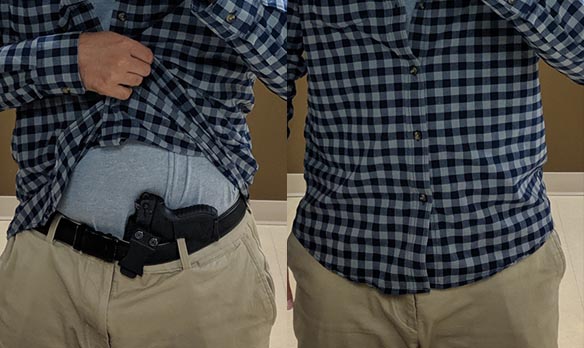
Your Pants and AIWB Holster Location
Another key to comfortable concealed carry in the appendix carry position is your wardrobe. If you haven’t checked out my proper pant sizing for IWB carry article, I highly suggest you take a look.
For appendix carry, make sure the clip of your AIWB holster is either to the left or right of the dominant hand front belt loop. Failing to do so can result in the holster coming unattached from your waistline. Additionally, this tends to cause discomfort since there is more material between the clip which makes adjusting holster difficult when sitting.Beyond proper pant sizing and holster location, your choice in undergarments can also make AIWB carry more comfortable.
What Undershirt To Use For AIWB Carry
In my time, I’ve found compression shirts provide the best undershirt to use when carrying AIWB. Compression shirts smooth out your draw, and are less likely to snag on an exposed hammer.
Unlike cotton or other material, compression style shirts won’t bunch up behind your holster making AIWB carry much more comfortable. You can see in several of the above images that my holster is causing my shirt to bunch to varying degrees. Furthermore, compression shirts hug your waistline, making bathroom breaks a little easier. No more trying to tuck in your shirt while maintaining your holster positioning.
Additionally, the polyester material prevents the rear of your slide from digging into your stomach by allowing the pistol to slide freely around your curves. This is beneficial for holsters which don’t have a padded backing running to the top of the slide. I’ve found this benefit most beneficial for fat guys carrying AIWB when they go to sit in their truck or at a desk.
Briefs vs. Boxers for AIWB Carry
I’m not trying to answer the age old question of which is better, boxers or briefs. However, in my experience, briefs do provide some substantial benefits for comfortable appendix carry. As referenced in the shirt choice section, you’re less likely to experience material bunching below your holster with briefs.
Loose fitting boxers can ride up and bunch between your holster and pants throughout daily activity. When sitting while wearing boxers, I often need to manually adjust the holster which tips others to the fact you are carrying concealed.
Additionally, it’s easier to insert your AIWB holster onto your waistline once fully dressed if your underwear hugs your contours. Once again, it’s easier to put yourself back together after going to the restroom with snug fitting undergarments.
Best Holsters For Appendix Carry
Alright, now that we covered strategies on how to appendix carry comfortably, I’ll give you some holster recommendations. If you are new to this carry position, I highly recommend that you get an appendix carry holster that allows for adjustable cant. Ideally, you’ll also be able to adjust the ride height as well, but I think cant is more important for a first appendix carry holster.
With that being said, many appendix carry holsters lack the ability to control cant. However, they have other features to make wearing them more comfortable. Sometimes holsters have a neo-prene or leather backing to aid in comfort. Other times, particularly with side-cart appendix holsters, you’ll have molded kydex and an additional belt clip.
Fixed holsters without cant adjustments are best for experienced appendix carry practitioners. While less forgiving than holsters with adjustable cant, once you grow accustomed to the holster your options are much more vast.
1. Concealment Express IWB Kydex Holster
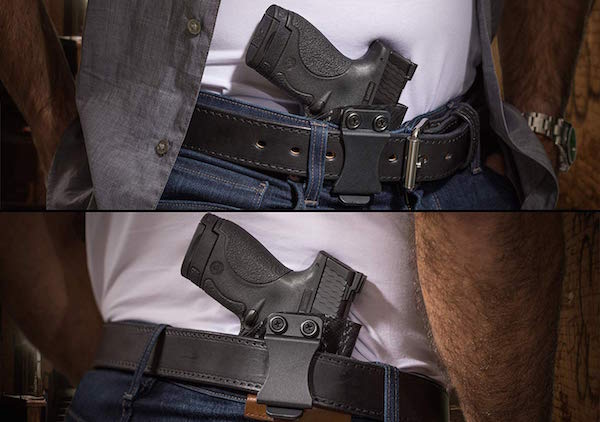
Here we have my personal choice for the best appendix carry holster, particularly if you’re familiar with appendix carry but still trying to work out your particulars. You can check out my full review here, but suffice it to say that this holster has adequate cant adjustment, and a slim profile. Because it isn’t bulky, it makes appendix carry much more comfortable.
2. Fierce Defender IWB Kydex Holster
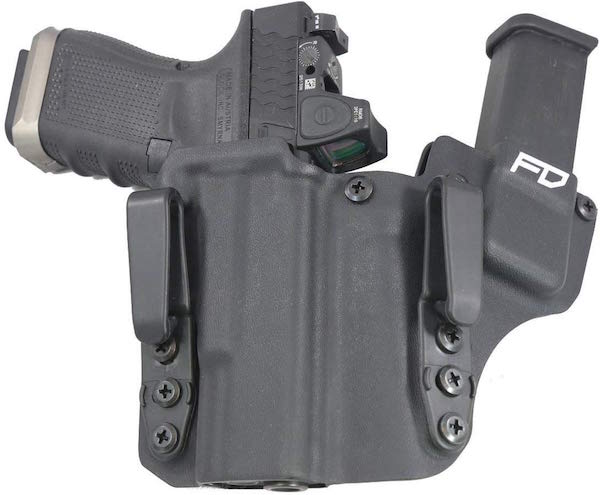
Next on the list, we’ve got a side-cart style appendix carry holster. With dual clips and rigid kydex construction, you can also carry an extra mag in this holster. However, this style is recommended for experienced appendix carry practitioners and there is no adjustable cant.
It can be a bit bulky for my tastes (I keep my spare mag in a mag holster on my hip). Some versions even come with the holster claw to keep the pistol grip tucked in tight. Similar to most other appendix carry kydex holsters, each is made to accommodate specific models.
3. DeSantis Slim Tuk
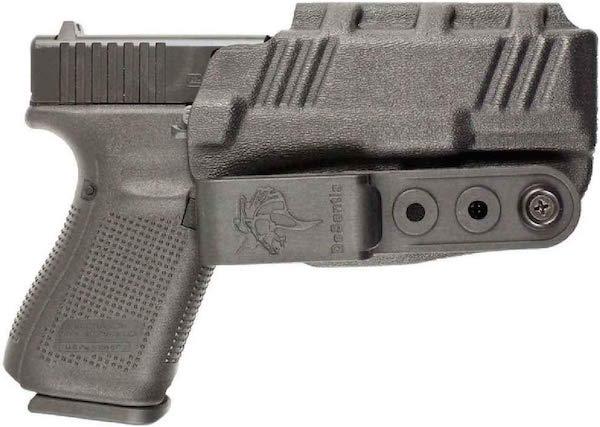
All of the adjustments you could possibly want. If you’re new to appendix carry, you should check out this holster to find the exact position, cant, and ride height you’ll look for in future holsters. Able to make fine adjustments with the turn of a screw, and an array of configurations. Just make sure you get the right holster to fit your handgun!
Parting Shots
Ultimately, how and where you wear your holster for appendix carry comes down to what feels the best for you. I’ve tried to provide tips that have helped me determine the most comfortable way to wear an AIWB holster for me. Hopefully, these tips come in handy for you. If you’ve found this content helpful, or have other tips for those looking for a way to make appendix carry more comfortable then please leave a comment.
